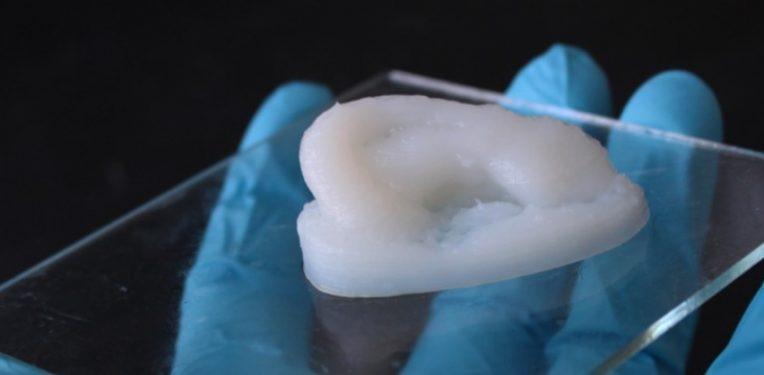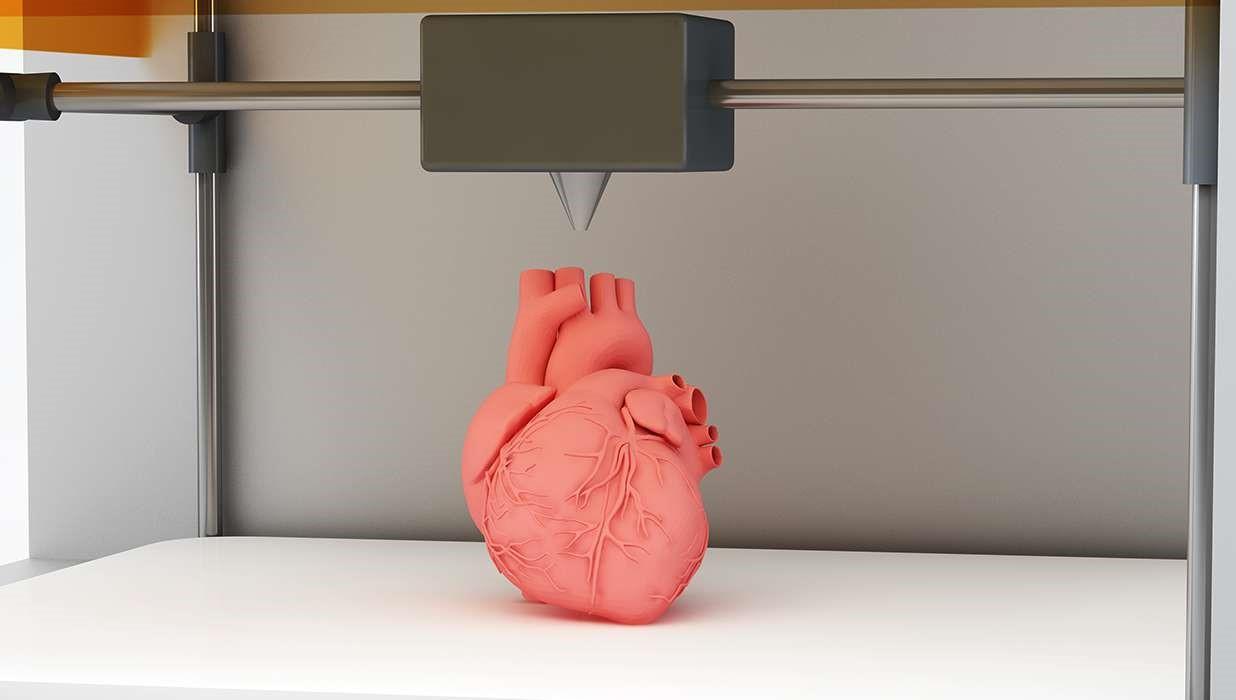
6 minute read
George Qiao
Our Future in a 3-D Printer
By Ryan Cvelbar
CareCloud, a privately held technology company headquartered out of Miami, states that according to recent figures, the average cost of an organ transplant in the U.S. can reach well over $1 million. Furthermore, according to the United Network for Organ Sharing (UNOS), more than 113,000 patients in the U.S. are currently waiting for an organ transplant. Anne Paschke of UNOS stresses this need for organs by expressing that only 1 to 2 percent of the population dies in a way that makes them potential organ donors. Although the need for organs has yet to be met, bioprinting has the potential of saving lives by addressing this chronic shortage through various applications. Many of you may have heard of 3-D printing, but have you heard of bioprinting? Bioprinting is a biotechnology that does not fail to excite optimists in the biotech industry. Specifically, bioprinting is “an additive manufacturing process where biomaterials such as hydrogels or other polymers are combined with cells and growth factors, and then printed to create tissue-like structures that imitate natural tissues” (What). You may be wondering how exactly this printing process takes place. Futurity explains that bioprinting involves using a computer-guided pipette that takes up cell cultures and “prints” them out in gel layers onto biopaper. This biopaper degrades over time; leaving behind the printed structure. According to the Australian Academy of Science (AAS), every tissue in the body is naturally made up of different cell types, so the required cells are taken from a patient and cultivated until there are enough to create cell specific ‘bio-ink’ that is loaded into the printer. Moreover, the AAS explains how these cells seek out similar cells to join with much like the way cells in an embryo develop in the womb during embryogenesis, or tissue in an adult moves to repair damage. Because the parts are synthesized from the organ recipient’s genetic matter and precisely match the tissue or organ being replaced, CareCloud states that there is less of a chance that the immune system will reject the foreign tissue. Now that we have covered the basics of sourcing, growing, and implanting bio-prints, let’s talk about bioprinting’s potential applications. From patient-specific surgical models and personalized medicines to replacement body parts and custom-made prosthetics, the possibilities of bioprinting are endless. A serious car accident that results in a passenger’s nose being shattered serves as a great example of a situation in which bioprinting can be put to use. According to the AAS, bioprinting technology makes it possible to reconstruct this nose as a 3D model on the computer. A biopsy can simultaneously be performed on the patient while cartilage cells are extracted from the knee, finger, ear or splinters of the shattered nose. The cells are reproduced in the laboratory and mixed with a biopolymer, which is then used to print a new nose to be implanted during surgery. In this process, the biopolymer is used as a form of shaping mold that is gradually broken down by the body and replaced by its own cells. This replacement leaves the implant unrecognizable as it appears cohesive with the individual’s own skin and cartilage. Moreover, Futurity forecasts that mass-supplied prosthetics are likely to be a thing of the past as 3D printing is increasingly used to manufacture prosthetics that are tailored to a patient’s anatomy and needs. For example, Futurity explains that surgeons have to cut a patient’s bone to fit the prosthetic in a hip-replacement, but in the future, it will be normal to 3D print a prosthetic to fit a patient. Additionally, bioprinting has extensive applications in the pharmaceutical industry with the potential to drastically reduce the need for animal trials in drug testing. Cellink contends that this technology offers the potential to test treatments for diseases using artificially affected tissues, eradicating organ donation and transplantation. Perhaps bioprinting’s most significant application is the use of 3D printed models to practice surgical operations. According to Jason Chuen, Director of Vascular Surgery at Austin Health and a Clinical Fellow at the University of Melbourne, studies have shown that operations can be completed faster and with less trauma for patients and the poten-

tial cost savings alone are considerable. Although these ideas sound both exciting and feasible, professionals have a long way to go until these applications become reality. Aside from potential applications of bioprinting in the medical field, professionals are currently making progress in the development of bioprinting as it pertains to some similar applications. “In 2003, Wake Forest succeeded in printing the first fully functional mini-kidney, which was able to filter blood and produce urine. Since then, scientists have been working to develop more sophisticated organs like hearts, livers and uteruses” (Carecloud). Chuen explains that once inside the gel, cells can die in a matter of minutes. This isn’t a problem for small structures like organoids, an artificially grown organ, that can be built quickly and then transferred back into a nutrient solution, but it is a problem when attempting to print an organ because the initial layers of cells will die before the organ is completed. Dave Fornell of Diagnostic and Interventional Cardiology argues that the Achilles heel of tissue engineering today is the need to create vascularity in the structure. He states that the key to printing vascularizable micro-organs involves chemical modifications of alginate hydrogels to promote organoid vascularity and suppress inflammatory responses. According to Fornell, what we can print right now are cardiac patches and small- to mediumsized blood vessels, skin tissue, soft tissue for reconstructive surgery, and vascularized micro-organs that can be grown in a bioreactor and used to supplement the function of a diseased organ like the liver. Recent breakthroughs in bioprinting include a team from Swansea University’s work that has developed a bioprinting process that can create an artificial bone matrix in the exact shape of the bone required. Mischa explains that, “Over a period of several months, the implants fuse with and are eventually replaced by a patient’s natural bones with few, if any, complications.” The AAS recognizes similar work at Wake Forest School of Medicine where researchers have successfully designed, built and tested a printer that can print skin cells directly onto a burn wound. Research engineer Monica Moya from Lawrence Livermore National Laboratory is also using bioprinting. The AAS explains how Moya is using the technology to create ‘living’ blood vessels by enabling small blood vessels to develop on their own. “Over a period of time, the self-assembled capillaries connect with the bio-printed tubes, thereby beginning to deliver nutrients to the cells on their own—mimicking the way these structures work in the human body” (science.org). Dr. Anthony Atala, director of the Wake Forest Institute for Regenerative Medicine, predicts that someday, perhaps in the span of a generation, you can have a heart made out of your own cell tissue. The biotechnology industry is growing at an unprecedented rate and the prospects of bioprinting applications like these give us a lot to look forward to.

References
Casarez, Carlos. “Where Does 3D Printing Stand in the Future of Medicine?” Continuum, Continuum, 15 Dec. 2016, www.carecloud.com/ continuum/3d-printing-future-of-medicine/. Markets, Research and. “3D Printing in Healthcare:
Insights Into & Future of the Market to 2024 by
Technology, Application, Material and Geography.” PR Newswire: Press Release Distribution, Targeting, Monitoring and Marketing, 17 July 2019, www.prnewswire.com/news-releases/3dprinting-in-healthcare-insights-into--future-ofthe-market-to-2024-by-technology-applicationmaterial-and-geography-300886816.html. Mischa. “Printing the Future: 3D Bioprinters and
Their Uses.” Curious, 23 Nov. 2017, www.science.org.au/curious/people-medicine/ bioprinting. “The Future of 3-D Printing in Medicine.” DAIC, 29
Jan. 2018, www.dicardiology.com/article/future -3-d-printing-medicine. “What Is 3D Bioprinting? – Simply Explained.” CELLINK, 26 Feb. 2020, cellink.com/what-is-3dbioprinting-simply-explained/. “5 Ways 3D Printing Could Totally Change Medicine.” Futurity, 25 Aug. 2017, www.futurity.org/3d-printing-transformingmedicine-1525732/.







